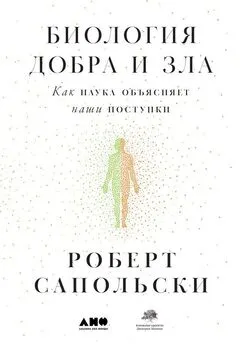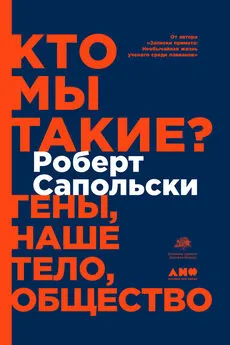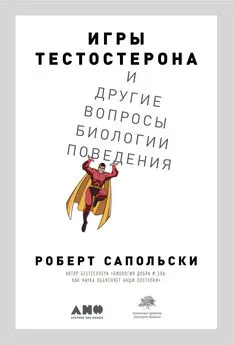Роберт Сапольски - Биология добра и зла. Как наука объясняет наши поступки
- Название:Биология добра и зла. Как наука объясняет наши поступки
- Автор:
- Жанр:
- Издательство:Альпина нон-фикшн
- Год:2019
- Город:Москва
- ISBN:978-5-0013-9051-0
- Рейтинг:
- Избранное:Добавить в избранное
-
Отзывы:
-
Ваша оценка:
Роберт Сапольски - Биология добра и зла. Как наука объясняет наши поступки краткое содержание
Биология добра и зла. Как наука объясняет наши поступки - читать онлайн бесплатно ознакомительный отрывок
Интервал:
Закладка:
747
R. Huber et al., “Neural Correlates of Informational Cascades: Brain Mechanisms of Social Influence on Belief Updating,” Neuroimage 249 (2010): 2687; G. Berns et al., “Neural Mechanisms of the Influence of Popularity on Adolescent Ratings of Music,” BP 58 (2005): 245; M. Edelson et al., “Following the Crowd: Brain Substrates of Long-Term Memory Conformity,” Sci 333 (2011): 108; H. L. Roediger and K. B. McDermott, “Remember When?” Sci 333 (2011): 47; J. Chen et al., “ERP Correlates of Social Conformity in a Line Judgment Task,” BMC Nsci 13 (2012): 43; K. Izuma, “The Neural Basis of Social Influence and Attitude Change,” Curr Opinion in Neurobiol 23 (2013): 456.
748
J. Zaki et al., “Social Influence Modulates the Neural Computation of Value,” Psych Sci 22 (2011): 894.
749
V. Klucharev et al., “Downregulation of the Posterior Medial Frontal Cortex Prevents Social Conformity,” J Nsci 31 (2011): 11934; См. также: A. Shestakova et al., “Electrophysiological Precursors of Social Conformity,” SCAN 8 (2013): 756; V. Klucharev et al., “Reinforcement Learning Signal Predicts Social Conformity,” Neuron 61 (2009): 140.
750
G. Berns et al., “Neurobiological Correlates of Social Conformity and Independence During Mental Rotation,” BP 58 (2005): 245.
751
S. Asch, “Opinions and Social Pressure,” Sci Am 193 (1955): 35; S. Asch, “Studies of Independence and Conformity: A Minority of One Against a Unanimous Majority,” Psych Monographs 70 (1956): 1.
752
S. Milgram, Obedience to Authority: An Experimental View (New York: HarperCollins, 1974).
753
C. Haney et al., “Study of Prisoners and Guards in a Simulated Prison,” Naval Research Rev 9 (1973): 1; C. Haney et al., “Interpersonal Dynamics in a Simulated Prison,” Int J Criminology and Penology 1 (1973): 69.
754
M. Banaji, “Ordinary Prejudice,” Psych Sci Agenda 8 (2001): 8.
755
К сноске: C. Hofling et al., “An Experimental Study of Nurse-Physician Relationships,” J Nervous and Mental Disease 141 (1966): 171.
756
S. Fiske et al., “Why Ordinary People Torture Enemy Prisoners,” Sci 306 (2004): 1482.
757
P. Zimbardo, The Lucifer Effect: Understanding How Good People Turn Evil (New York: Random House, 2007).
758
Там же.
759
G. Perry, Behind the Shock Machine: The Untold Story of the Notorious Milgram Psych Experiments (New York: New Press, 2013).
760
T. Carnahan and S. McFarland, “Revisiting the Stanford Prison Experiment: Could Participant Self-Selection Have Led to the Cruelty?” PSPB 33 (2007): 603; S. H. Lovibond et al., “Effects of Three Experimental Prison Environments on the Behavior of Non-convict Volunteer Subjects,” Psychologist 14 (1979): 273.
761
S. Reiche and S. A. Haslam, “Rethinking the Psychology of Tyranny: The BBC Prison Study,” Brit J Soc Psych 45 (2006): 1; S. A. Haslam and S. D. Reicher, “When Prisoners Take Over the Prison: A Social Psychology of Resistance,” PSPR 16 (2012): 154.
762
P. Zimbardo, “On Rethinking the Psychology of Tyranny: The BBC Prison Study,” Brit J Soc Psych 45 (2006): 47.
763
A. Abbott, “How the Brain Responds to Orders,” Nat 530 (2016): 394.
764
B. Müller-Hill, Murderous Science: Elimination by Scientific Selection of Jews, Gypsies, and Others, Germany 1933–1945 (Oxford: Oxford University Press, 1988).
765
S. Asch, “Opinions and Social Pressure,” Sci Am, 193 (1955): 35.
766
R. Sapolsky, “Measures of Life,” Sciences , March/April 1994, p. 10.
767
R. Watson, “Investigation into Deindividuation Using a Cross-Cultural Survey Technique,” JPSP 25 (1973): 342.
768
A. Bandura et al., “Disinhibition of Aggression Through Diffusion of Responsibility and Dehumanization of Victims,” J Res in Personality 9 (1975): 253.
769
L. Bègue et al., “Personality Predicts Obedience in a Milgram Paradigm,” J Personality 83 (2015): 299; V. Zeigler-Hill, et al., “Neuroticism and Negative Affect Influence the Reluctance to Engage in Destructive Obedience in the Milgram Paradigm,” J Soc Psych 153 (2013): 161; T. Blass, “Right-Wing Authoritarianism and Role as Predictors of Attributions About Obedience to Authority,” Personality and Individual Differences 1 (1995): 99; P. Burley and J. McGuinnes, “Effects of Social Intelligence on the Milgram Paradigm,” Psych Rep 40 (1977): 767.
770
A. H. Eagly and L. L. Carli, “Sex of Researchers and Sex-Typed Communications as Determinants of Sex Differences in Influenceability: A Meta-analysis of Social Influence Studies,” Psych Bull 90 (1981): 1; S. Ainsworth and J. Maner, “Sex Begets Violence: Mating Motives, Social Dominance, and Physical Aggression in Men,” JPSP 103 (2012): 819; H. Reitan and M. Shaw, “Group Membership, Sex-Composition of the Group, and Conformity Behavior,” J Soc Psych 64 (1964): 45.
771
S. Milgram, “Nationality and Conformity,” Sci Am 205 (1961): 45.
772
A. Shenhav and J. D. Greene, “Moral Judgments Recruit Domain-General Valuation Mechanisms to Integrate Representations of Probability and Magnitude,” Neuron 67 (2010): 667; P. N. Tobler et al., “The Role of Moral Utility in Decision Making: An Interdisciplinary Framework,” Cog, Affective & Behav Nsci 8 (2008): 390; B. Harrison et al., “Neural Correlates of Moral Sensitivity in OCD,” AGP 69 (2012): 741.
773
L. Young et al., “The Neural Basis of the Interaction Between Theory of Mind and Moral Judgment,” PNAS 104 (2007): 8235; L. Young and R. Saxe, “Innocent Intentions: A Correlation Between Forgiveness for Accidental Harm and Neural Activity,” Neuropsychologia 47 (2009): 2065; L. Young et al., “Disruption of the Right Temporoparietal Junction with TMS Reduces the Role of Beliefs in Moral Judgments,” PNAS 107 (2009): 6753; L. Young and R. Saxe, “An fMRI Investigation of Spontaneous Mental State Inference for Moral Judgment,” J Cog Nsci 21 (2009): 1396.
774
J. Knobe, “Intentional Action and Side Effects in Ordinary Language Analysis,” 63 (2003): 190; J. Knobe, “Theory of Mind and Moral Cognition: Exploring the Connections,” TICS 9 (2005): 357.
775
J. Knobe, “Theory of Mind and Moral Cognition: Exploring the Connections,” TICS 9 (2005): 357.
776
P. Singer, “Sidgwick and Reflective Equilibrium,” Monist 58 (1974), reprinted in Unsatisfying Human Life , ed. H. Kulse (Oxford: Blackwell, 2002).
777
J. Haidt, “The Emotional Dog and Its Rational Tail: A Social Intuitionist Approach to Moral Judgment,” PsychRev 108 (2001): 814–34; J. Haidt, “The New Synthesis in Moral Psychology,” Sci 316 (2007): 996.
778
J. S. Borg et al., “Infection, Incest, and Iniquity: Investigating the Neural Correlates of Disgust and Morality,” J Cog Nsci 20 (2008): 1529.
779
M. Haruno and C. D. Frith, “Activity in the Amygdala Elicited by Unfair Divisions Predicts Social Value Orientation,” Nat Nsci 13 (2010): 160; C. D. Batson, “Prosocial Motivation: Is It Ever Truly Altruistic?” Advances in Exp. Soc Psych 20 (1987): 65; A. G. Sanfey et al., “The Neural Basis of Economic Decision-Making in the Ultimatum Game,” Sci 300 (2003): 1755.
780
J. Van Bavel et al., “The Importance of Moral Construal: Moral Versus Non-moral Construal Elicits Faster, More Extreme, Universal Evaluations of the Same Actions,” PLoS ONE 7 (2012): e48693.
781
G. Miller, “The Roots of Morality,” Sci 320 (2008): 734.
782
По поводу рудиментов морали у маленьких детей см. прекрасную работу P. Bloom, Just Babies: The Origins of Good and Evil (Portland, OR: Broadway Books, 2014). Информация для соответствующих абзацев приведена по этому источнику.
783
S. F. Brosnan and F. B. M. de Waal, “Monkeys Reject Unequal Pay,” Nat 425 (2003): 297.
784
F. Range et al., “The Absence of Reward Induces Inequity Aversion in Dogs,” PNAS 106 (2009): 340; C. Wynne “Fair Refusal by Capuchin Monkeys,” Nat 428 (2004): 140; D. Dubreuil et al., “Are Capuchin Monkeys ( Cebus apella ) Inequity Averse?” Proc Royal Soc of London B 273 (2006): 1223.
785
S. F. Brosnan and F. B. M. de Waal, “Evolution of Responses to (un)Fairness,” Sci 346 (2014): 1251776; S. F. Brosnan et al., “Mechanisms Underlying Responses to Inequitable Outcomes in Chimpanzees, Pan troglodytes ,” Animal Behav 79 (2010): 1229; M. Wolkenten et al., “Inequity Responses of Monkeys Modified by Effort,” PNAS 104 (2007): 18854.
786
K. Jensen et al., “Chimpanzees Are Rational Maximizers in an Ultimatum Game,” Sci 318 (2007): 107; D. Proctor et al., “Chimpanzees Play the Ultimatum Game,” PNAS 110 (2013): 2070.
787
V. R. Lakshminarayanan and L. R. Santos, “Capuchin Monkeys Are Sensitive to Others’ Welfare,” Curr Biol 17 (2008): 21; J. M. Burkart et al., “Other-Regarding Preferences in a Non-human Primate: Common Marmosets Provision Food Altruistically,” PNAS 104 (2007): 19762; J. B. Silk et al., “Chimpanzees Are Indifferent to the Welfare of Unrelated Group Members,” Nat 437 (2005); 1357; K. Jensen et al., “What’s in It for Me? Self-Regard Precludes Altruism and Spite in Chimpanzees,” Proc Royal Soc B 273 (2006): 1013; J. Vonk et al., “Chimpanzees Do Not Take Advantage of Very Low Cost Opportunities to Deliver Food to Unrelated Group Members,” Animal Behav 75 (2008): 1757.
788
F. De Waal and S. Macedo, Primates and Philosophers: How Morality Evolved (Princeton, NJ: Princeton Science Library, 2009).
789
B. Thomas et al., “Harming Kin to Save Strangers: Further Evidence for Abnormally Utilitarian Moral Judgments After Ventromedial Prefrontal Damage,” J Cog Nsci 23 (2011): 2186.
790
Интервал:
Закладка:





![Роберт Сапольски - Игры тестостерона и другие вопросы биологии поведения [litres]](/books/1074102/robert-sapolski-igry-testosterona-i-drugie-vopros.webp)




